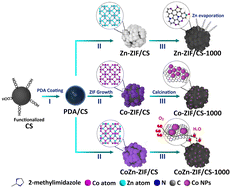Bottom-up preparation of hierarchically porous MOF-modified carbon sphere derivatives for efficient oxygen reduction†‡
Abstract
The rational design and controllable preparation of carbon-based catalysts for oxygen reduction reactions (ORRs) are at the core of key technologies for fuel cells and chargeable batteries in the field of advanced energy conversion and storage. In the present study, a Co species was synthesized by tuning the Zn dopant content in a bimetallic zeolitic-imidazolate framework functionalized with carbon spheres (CoZn-ZIF/CS). Using CoZn-ZIF/CS as the precursor, Co nanoparticles on N-doped carbon spheres were generated at 1000 °C (CoZn-ZIF/CS-1000). These systems were bottom-up synthesized and extensiv ely investigated for their ORR performance. The Brunauer–Emmett–Teller surface area and total pore volume with values of 586 m2 g−1 and 0.39 cm3 g−1, respectively, for the CoZn-ZIF/CS-1000 are appropriate compared to those of the porous ZIF precursor. As expected, it exhibited high-activity ORR performance in an alkaline medium with a half-wave potential of 0.82 V vs. RHE and the diffusion-limited current density is 5.11 mV cm−2. Meanwhile, the obtained CoZn-ZIF/CS-1000 electrocatalyst shows better electrochemical stability and methanol tolerance than the commercial Pt/C. Therefore, our discovery opens up a new way to regulate the catalytic performance of carbon material templates and MOF derivatives, which could be further applied in the development of highly active catalysts for applications in chemical energy utilization.

- This article is part of the themed collection: Celebrating 60 years of the Fujian Institute of Research on the Structure of Matter


 Please wait while we load your content...
Please wait while we load your content...